User Education in Automated Driving: Owner’s Manual and Interactive Tutorial Support Mental Model Formation and Human-Automation Interaction
Abstract
1. Introduction
1.1. Background
1.2. Owner’s Manual Based User Education
1.3. Tutorial Based User Education
1.4. Aims and Objectives
2. Materials and Methods
2.1. Driving Simulation and Automated Driving System
2.2. Study Design and Procedure
2.3. Human-Machine Interface
2.4. Use Cases
2.5. User Education Approaches
2.5.1. Baseline Information
2.5.2. Owner’s Manual
2.5.3. Interactive Tutorial
2.6. Dependent Variables
2.7. Sample Characteristics
3. Results
3.1. Mental Model Questionnaire
3.2. Interaction Performance Ratings
4. Discussion
4.1. Mental Model
4.2. Interaction Performance
4.3. Limitations and Future Research
5. Conclusions
Author Contributions
Funding
Acknowledgments
Conflicts of Interest
Appendix A
%Set number of bootstrap replicates nrep=10000; %Create space for bootstrap replicates mean_BL=zeros(1, nrep); mean_ML=zeros(1, nrep); mean_TL=zeros(1, nrep); %Start for loop for i=1:nrep %draw a random sample with replacement from each condition sample_Baseline=randsample(MM_L3_BL, length(MM_HAF_BL), true); sample_Manual=randsample(MM_L3_ML, length(MM_HAF_ML), true); sample_Tutorial=randsample(MM_L3_TL, length(MM_HAF_TL), true); %calculate mean from each random sample and store in array mean_BL(i)=mean(sample_Baseline); mean_ML(i)=mean(sample_Manual); mean_TL(i)=mean(sample_Tutorial); end
References
- SAE. Taxonomy and Definitions for Terms Related to On-Road Motor Vehicle Automated Driving Systems; SAE International: Warrendale, PE, USA, 2018. [Google Scholar]
- Naujoks, F.; Wiedemann, K.; Schömig, N.; Hergeth, S.; Keinath, A. Towards guidelines and verification methods for automated vehicle HMIs. Transp. Res. Part F Traff. Psychol. Behav. 2019, 60, 121–136. [Google Scholar] [CrossRef]
- NHTSA. Federal Automated Vehicles Policy. Accelerating the Next Revolution in Roadway Safety; NHTSA: Washington, DC, USA, 2016.
- Crundall, D.; Andrews, B.; Van Loon, E.; Chapman, P. Commentary training improves responsiveness to hazards in a driving simulator. Accid. Anal. Prev. 2010, 42, 2117–2124. [Google Scholar] [CrossRef] [PubMed]
- Pradhan, A.K.; Pollatsek, A.; Knodler, M.; Fisher, D.L. Can younger drivers be trained to scan for information that will reduce their risk in roadway traffic scenarios that are hard to identify as hazardous? Ergonomics 2009, 52, 657–673. [Google Scholar] [CrossRef]
- Bainbridge, L. Ironies of automation. Automatica 1983, 19, 775–779. [Google Scholar] [CrossRef]
- Endsley, M.R. Autonomous driving systems: A preliminary naturalistic study of the Tesla Model S. J. Cogn. Eng. Decis. Mak. 2017, 11, 225–238. [Google Scholar] [CrossRef]
- Pradhan, A.K.; Sullivan, J.; Schwarz, C.; Feng, F.; Bao, S. Training and Education: Human Factors Considerations for Automated Driving Systems. In Road Vehicle Automation 5; Meyer, G., Beiker, S., Eds.; Springer: Cham, Switzerland, 2019; pp. 77–84. [Google Scholar]
- Jarosch, O.; Kuhnt, M.; Paradies, S.; Bengler, K. It’s Out of Our Hands Now! Effects of Non-Driving Related Tasks during Highly Automated Driving on Drivers’ Fatigue. In Proceedings of the 9th International Driving Symposium on Human Factors in Driver Assessment, Training, and Vehicle Design, Manchester Village, VT, USA, 26–29 June 2017. [Google Scholar]
- Forster, Y.; Naujoks, F.; Neukum, A. Increasing anthropomorphism and trust in automated driving functions by adding speech output. In Proceedings of the IEEE Intelligent Vehicles Symposium, Redondo Beach, CA, USA, 11–14 June 2017. [Google Scholar]
- Hergeth, S.; Lorenz, L.; Krems, J.F. Prior familiarization with takeover requests affects drivers’ takeover performance and automation trust. Hum. Factors 2017, 59, 457–470. [Google Scholar] [CrossRef] [PubMed]
- Feldhütter, A.; Segler, C.; Bengler, K. Does Shifting Between Conditionally and Partially Automated Driving Lead to a Loss of Mode Awareness? In Proceedings of the International Conference on Applied Human Factors and Ergonomics, Los Angeles, CA, USA, 17–21 July 2017. [Google Scholar]
- Naujoks, F.; Mai, C.; Neukum, A. The effect of urgency take-over requests during highly automated driving under distraction conditions. Adv. Hum. Asp. Transp. 2014, 7, 431. [Google Scholar]
- Forster, Y.; Hergeth, S.; Naujoks, F.; Krems, J.F. How Usability can Save the Day. Methodological Considerations for Making Automated Driving a Success Story. In Proceedings of the 10th International Conference on Automotive User Interfaces and Interactive Vehicular Applications, Toronto, ON, Canada, 23–25 September 2018; Donmez, B., Walker, B.N., Fröhlich, K., Eds.; ACM: New York, NY, USA, 2018. [Google Scholar]
- Forster, Y.; Hergeth, S.; Naujoks, F.; Beggiato, M.; Krems, J.F.; Keinath, A. Learning to Use Automation: Behavioral Changes in Interaction with Automated Driving Systems. Transp. Res. Part F Traff. Psychol. Behav. 2019, 62, 599–614. [Google Scholar] [CrossRef]
- Beggiato, M.; Pereira, M.; Petzoldt, T.; Krems, J. Learning and development of trust, acceptance and the mental model of ACC. A longitudinal on-road study. Transp. Res. Part F Traff. Psychol. Behav. 2015, 35, 75–84. [Google Scholar] [CrossRef]
- Forster, Y.; Hergeth, S.; Naujoks, F.; Beggiato, M.; Krems, J.F.; Keinath, A. Learning and Development of Mental Models in Interaction with Driving Automation: A Simulator Study. In Proceedings of the 10th International Driving Symposium on Human Factors in Driver Assessment, Training, and Vehicle Design, Santa Fe, NM, USA, 24–27 June 2019. [Google Scholar]
- Naujoks, F.; Hergeth, S.; Wiedemann, K.; Schömig, N.; Keinath, A. Use Cases for Assessing, Testing, and Validating the Human Machine Interface of Automated Driving Systems. Proc. Hum. Factors Ergon. Soc. Annu. Meet. 2018, 62, 1873–1877. [Google Scholar] [CrossRef]
- Wickens, C.D. Multiple resources and performance prediction. Theor. Issues Ergon. Sci. 2002, 3, 159–177. [Google Scholar] [CrossRef]
- Knappe, G.; Keinath, A.; Meinecke, C. Empfehlungen für die Bestimmung der Spurhaltegüte im Kontext der Fahrsimulation. MMi-Interaktiv 2006, 11, 3–13. [Google Scholar]
- AAM. Statement of Principles, Criteria and Verification Procedures on Driver Interactions with Advanced in-Vehicle Information and Communication Systems; Alliance of Automobile Manufactures: Washington, DC, USA, 2006. [Google Scholar]
- NHTSA. Visual-Manual NHTSA Driver Distraction Guidelines for in-Vehicle Electronic Devices; National Highway Traffic Safety Administration (NHTSA), Department of Transportation (DOT): Washington, DC, USA, 2012.
- Forster, Y.; Naujoks, F.; Neukum, A.; Huestegge, L. Driver compliance to take-over requests with different auditory outputs in conditional automation. Accid. Anal. Prev. 2017, 109, 18–28. [Google Scholar] [CrossRef] [PubMed]
- Beller, J.; Heesen, M.; Vollrath, M. Improving the driver–automation interaction: An approach using automation uncertainty. Hum. Factors 2013, 55, 1130–1141. [Google Scholar] [CrossRef]
- Louw, T.; Merat, N. Are you in the loop? Using gaze dispersion to understand driver visual attention during vehicle automation. Transp. Res. Part C Emerg. Technol. 2017, 76, 35–50. [Google Scholar] [CrossRef]
- Trösterer, S.; Meschtscherjakov, A.; Mirnig, A.G.; Lupp, A.; Gärtner, M.; McGee, F.; McCall, R.; Tscheligi, M.; Engel, T. What We Can Learn from Pilots for Handovers and (De)Skilling in Semi-Autonomous Driving. In Proceedings of the 9th International Conference on Automotive User Interfaces and Interactive Vehicular Applications, Oldenburg, Germany, 24–27 September 2017; Boll, S., Pfleging, B., Donmez, B., Eds.; ACM: New York, NY, USA, 2017; pp. 173–182. [Google Scholar]
- Fitts, P.M.; Posner, M.I. Human Performance; Brooks/Cole: Oxford, UK, 1967. [Google Scholar]
- Mehlenbacher, B.; Wogalter, M.S.; Laughery, K.R. On the Reading of Product Owner’s Manuals: Perceptions and Product Complexity. Proc. Hum. Factors Ergon. Soc. Annu. Meet. 2002, 46, 730–734. [Google Scholar] [CrossRef]
- Wickens, C.D.; Hollands, J.G.; Banbury, S.; Parasuraman, R. Engineering Psychology & Human Performance; Psychology Press: Hove, UK, 2015. [Google Scholar]
- Van Loggem, B. User Documentation: The Cinderella of Information Systems. In Advances in Information Systems and Technologies; Rocha, Á., Correia, A.M., Wilson, T., Stroetmann, K.A., Eds.; Springer: Berlin/Heidelberg, Germany, 2013; pp. 167–177. [Google Scholar]
- Beggiato, M.; Krems, J.F. The evolution of mental model, trust and acceptance of adaptive cruise control in relation to initial information. Transp. Res. Part F Traff. Psychol. Behav. 2013, 18, 47–57. [Google Scholar] [CrossRef]
- Blömacher, K.; Nöcker, G.; Huff, M. The role of system description for conditionally automated vehicles. Transp. Res. Part F Traff. Psychol. Behav. 2018, 54, 159–170. [Google Scholar] [CrossRef]
- Forster, Y.; Kraus, J.; Feinauer, S.; Baumann, M. Calibration of Trust Expectancies in Conditionally Automated Driving by Brand, Reliability Information and Introductionary Videos: An online study. In Proceedings of the 10th International Conference on Automotive User Interfaces and Interactive Vehicular Applications, Toronto, ON, Canada, 23–25 September 2018; Donmez, B., Walker, B.N., Fröhlich, K., Eds.; ACM: New York, NY, USA, 2018. [Google Scholar]
- Körber, M.; Baseler, E.; Bengler, K. Introduction matters: Manipulating trust in automation and reliance in automated driving. Appl. Ergon. 2018, 66, 18–31. [Google Scholar] [CrossRef]
- Hock, P.; Kraus, J.; Walch, M.; Lang, N.; Baumann, M. Elaborating Feedback Strategies for Maintaining Automation in Highly Automated Driving. In Proceedings of the 8th International Conference on Automotive User Interfaces and Interactive Vehicular Applications, Ann Arbor, MI, USA, 24–26 October 2016; pp. 105–112. [Google Scholar]
- Slater, M. A note on presence terminology. Presence Connect 2003, 3, 1–5. [Google Scholar]
- Brehm, J.W. A Theory of Psychological Reactance; Academic Press: New York, NY, USA, 1966. [Google Scholar]
- Pradhan, A.K.; Fisher, D.L.; Pollatsek, A. The effect of PC-based training on novice driver’ risk awareness in a driving simulator. In Proceedings of the 3rd International Driving Symposium on Human Factors in Driver Assessment, Training, and Vehicle Design, Rockport, ME, USA, 27–30 June 2005. [Google Scholar]
- Yamani, Y.; Samuel, S.; Knodler, M.A.; Fisher, D.L. Evaluation of the effectiveness of a multi-skill program for training younger drivers on higher cognitive skills. Appl. Ergon. 2006, 52, 135–141. [Google Scholar] [CrossRef] [PubMed]
- Payre, W.; Cestac, J.; Dang, N.T.; Vienne, F.; Delhomme, P. Impact of training and in-vehicle task performance on manual control recovery in an automated car. Transp. Res. Part F Traff. Psychol. Behav. 2017, 46, 216–227. [Google Scholar] [CrossRef]
- Gagne, R. Learning Outcomes and Their Effects. Useful Categories of Human Performance. Am. Psychol. 1984, 39, 377–385. [Google Scholar] [CrossRef]
- Forster, Y.; Naujoks, F.; Neukum, A. Your Turn or My Turn? Design of a Human-Machine Interface for Conditional Automation. In Proceedings of the 8th International Conference on Automotive User Interfaces and Interactive Vehicular Applications, Ann Arbor, MI, USA, 24–26 October 2016; pp. 253–260. [Google Scholar]
- Manca, L.; de Winter, J.C.F.; Happee, R. Visual Displays for Autoamted Driving: A Survey. In Adjunct Proceedings of the 7th International Conference on Automotive User Interfaces and Itneractive Vehicular Applications; Association for Computing Machinery: New York, NY, USA, 2015. [Google Scholar]
- Naujoks, F.; Purucker, C.; Neukum, A.; Wolter, S.; Steiger, R. Controllability of Partially Automated Driving functions–Does it matter whether drivers are allowed to take their hands off the steering wheel? Transp. Res. Part F Traff. Psychol. Behav. 2015, 35, 185–198. [Google Scholar] [CrossRef]
- Naujoks, F.; Forster, Y.; Wiedemann, K.; Neukum, A. A Human-Machine Interface for Cooperative Highly Automated Driving. In Advances in Human Aspects of Transportation; Springer: Cham, Switzerland, 2016; pp. 585–595. [Google Scholar]
- Nevitt, J.; Hancock, G.R. Performance of Bootstrapping Approaches to Model Test Statistics and Parameter Standard Error Estimation in Structural Equation Modeling. Struct. Equ. Model. 2001, 8, 353–377. [Google Scholar] [CrossRef]
- Keselman, H.J.; Wilcox, R.R.; Othman, A.R.; Fradette, K. Trimming, Transforming Statistics, and Bootstrapping: Circumventing the Biasing Effects of Heterescedasticity and Nonnormality. J. Mod. Appl. Stat. Methods 2002, 1, 288–309. [Google Scholar] [CrossRef]
- Schäfer, T. Die New Statistics in der Psychologie. Zeitschrift für Entwicklungspsychologie und Pädagogische Psychologie 2018, 50, 3–18. [Google Scholar]
- Cumming, G. Understanding the New Statistics: Effect Sizes, Confidence Intervals, and Meta-Analysis; Routledge: Abingdon, UK, 2013. [Google Scholar]
- Cumming, G.; Finch, S. Inference by eye: Confidence intervals and how to read pictures of data. Am. Psychol. 2005, 60, 170. [Google Scholar] [CrossRef]
- Davis, F.D. Perceived Usefulness, Perceived Ease of Use, and User Acceptance of Information Technology. MIS Q. 1989, 13, 319. [Google Scholar] [CrossRef]
- Sarter, N.B.; Mumaw, R.J.; Wickens, C.D. Pilots’ monitoring strategies and performance on automated flight decks: An empirical study combining behavioral and eye-tracking data. Hum. Factors 2007, 49, 347–357. [Google Scholar] [CrossRef]
- Hart, C.A. Self Driving Safety Steps into the Unknown. Available online: http://www.thedrive.com/tech/26896/self-driving-safety-steps-into-the-unknown (accessed on 14 March 2019).
- McIlwraith, A. Information Security and Employee Behaviour: How to Reduce Risk through Employee Education, Training and Awareness; Routledge: Abingdon, UK, 2016. [Google Scholar]
- Michon, J.A. A critical view of driver behavior models: What do we know, what should we do? In Human Behavior and Traffic Safety; Springer: Boston, MA, USA, 1985; pp. 485–524. [Google Scholar]
- Forster, Y.; Hergeth, S.; Naujoks, F.; Krems, J.F. Unskilled and Unaware: Subpar Users of Automated Driving Systems Make Spurious Decisions. In Proceedings of the 10th International Conference on Automotive User Interfaces and Interactive Vehicular Applications, Toronto, ON, Canada, 23–25 September 2018; ACM: New York, NY, USA, 2018. [Google Scholar]
- Norman, G. Likert scales, levels of measurement and the “laws” of statistics. Adv. Health Sci. Educ. Theory Pract. 2010, 15, 625–632. [Google Scholar] [CrossRef] [PubMed]
- Kauffmann, N.; Winkler, F.; Vollrath, M. What Makes an Automated Vehicle a Good Driver? In Proceedings of the CHI Conference, Montreal, QC, Canada, 21–26 April 2018. [Google Scholar]
- Neukum, A.; Lübbecke, T.; Krüger, H.-P.; Mayser, C.; Steinle, J. ACC-Stop&Go: Fahrerverhalten an Funktionalen SYSTEMGRENZEN, 5. Workshop Fahrerassistenzsysteme—FAS. 2008. Available online: http://www2.psychologie.uni-wuerzburg.de/izvw/texte/2008_Neukum_etal_ACC_Stop&Go.pdf (accessed on 16 April 2019).
- Norman, D. The Design of Everyday Things: Revised and Expanded Edition; Basic Books: New York, NY, USA, 2013. [Google Scholar]

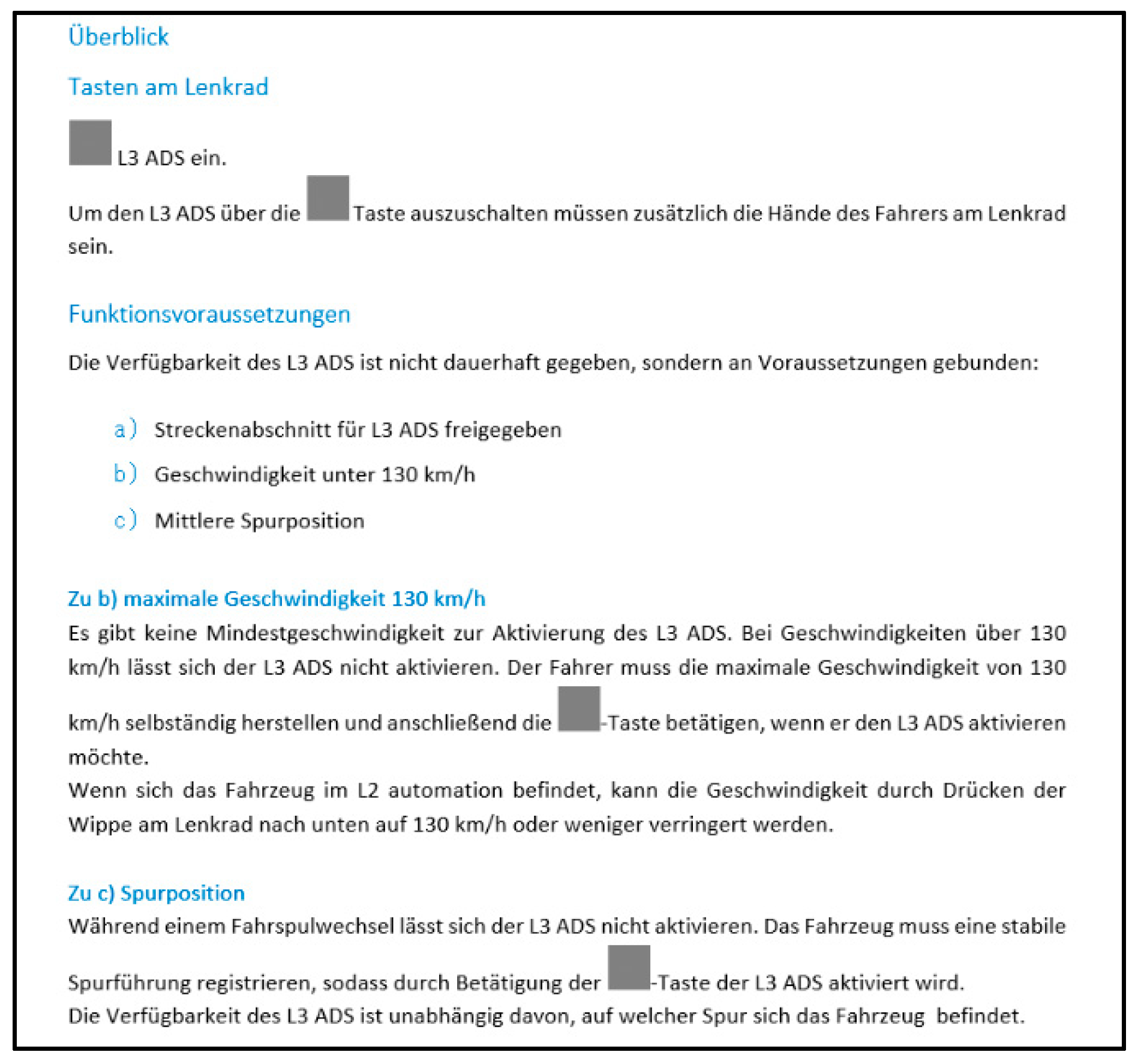
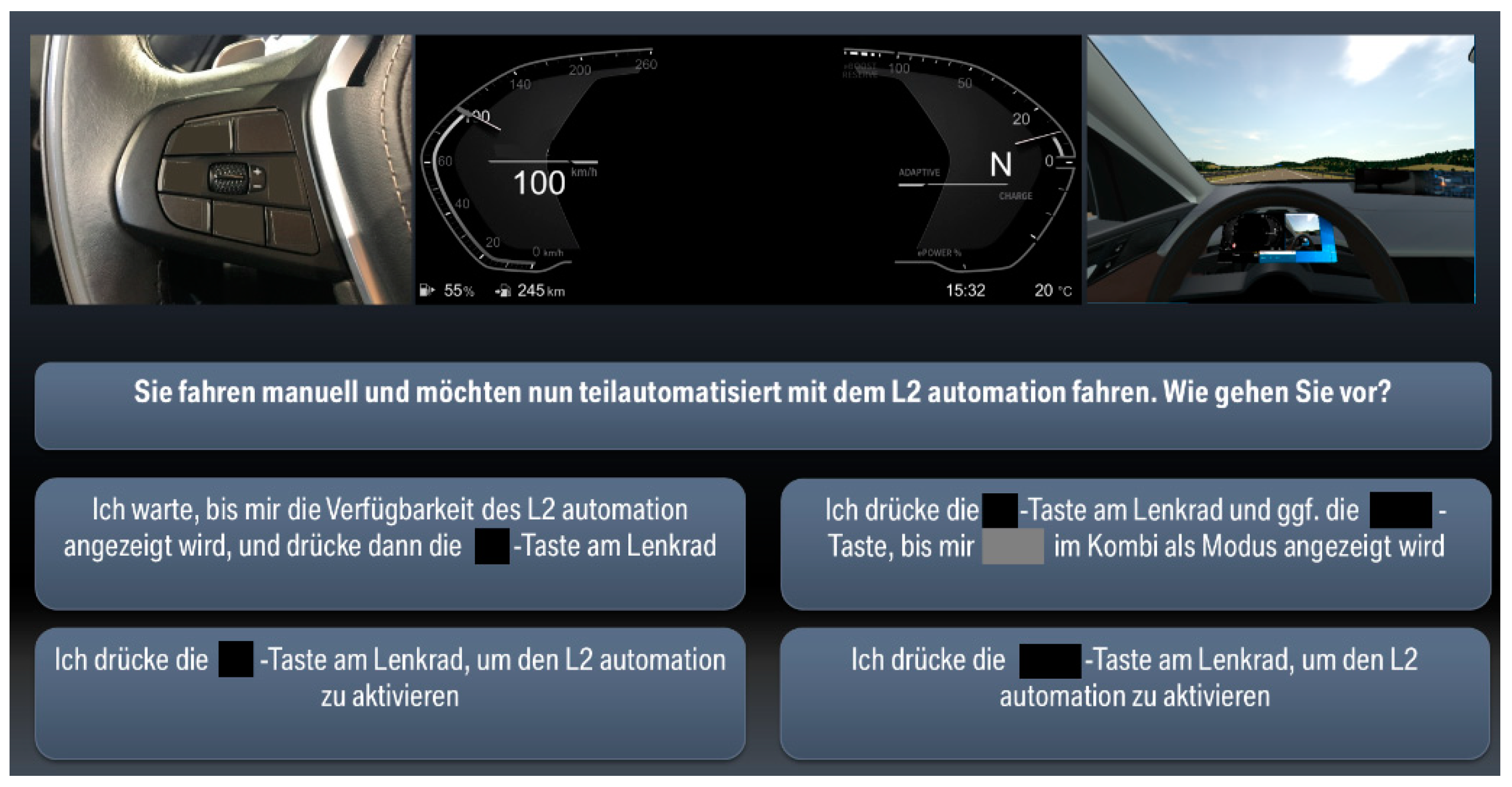
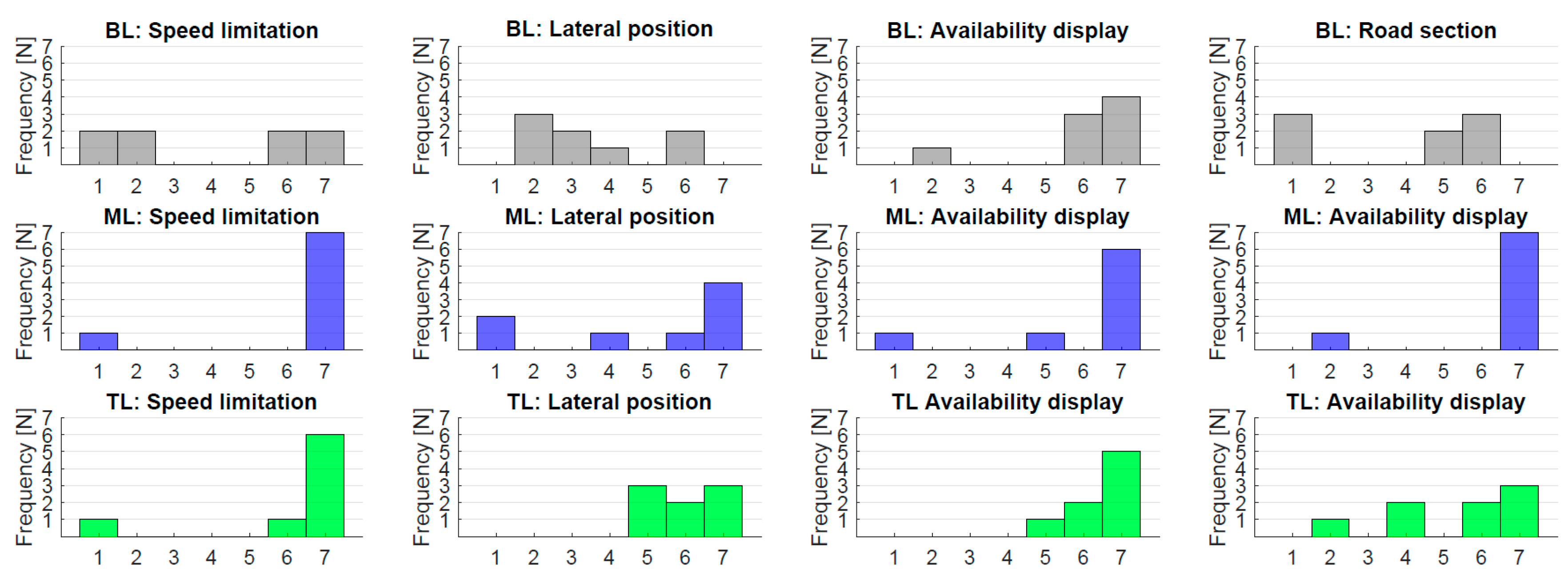
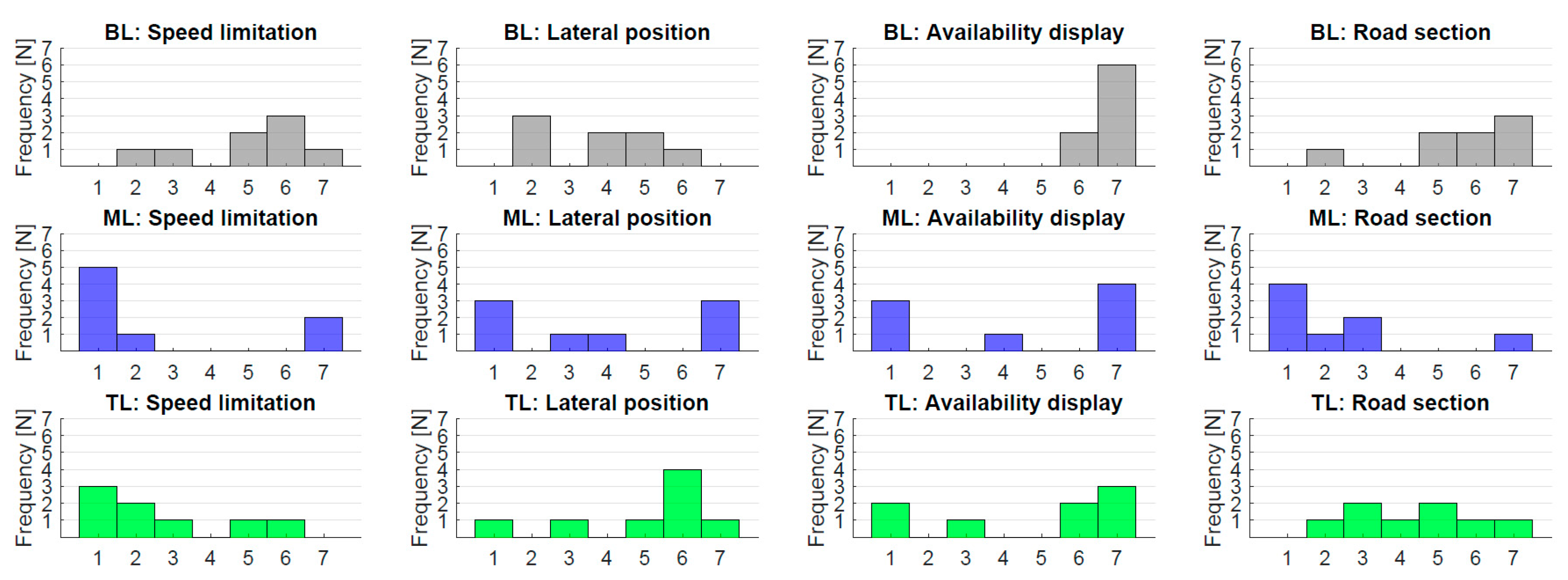
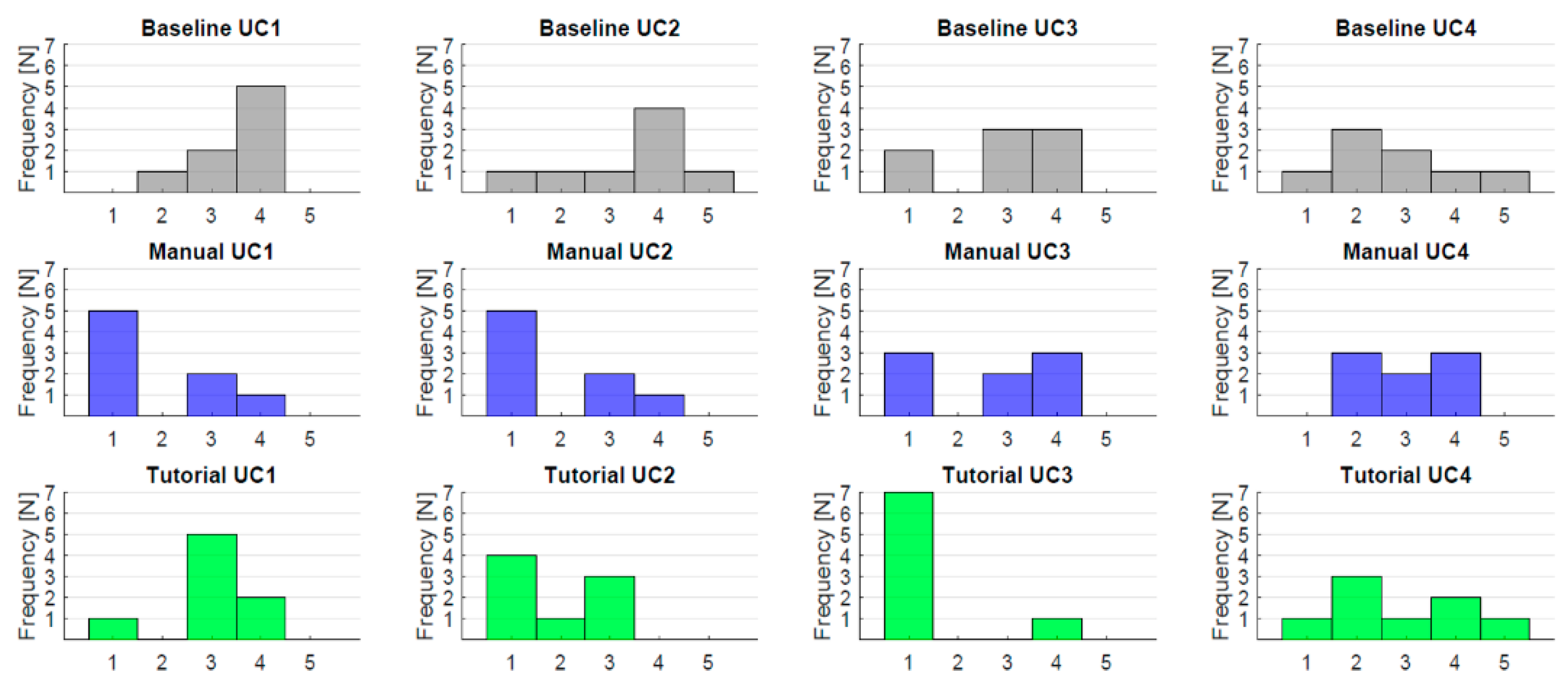
| Characteristic | Source | Owner’s Manual | Interactive Tutorial |
|---|---|---|---|
| Type of learning | [29] | Passive learning | Active learning |
| [5,29] | Unguided/uncontrolled learning | Guided learning/experimental control | |
| Focus of education | [30] | System focused | Use case focused |
| Type of information | N/A | Correct information only | Presence of distracting information |
| Degree of realism | [36] | Abstract representation of HM | Immersive representation of HMI |
| User Education | Preparation | Experimental Drive | |||
|---|---|---|---|---|---|
| Education application | Mental Model questionnaire | Familiarization drive (manual) | Instructions | Control transitions | Inquiry |
| Transition Type | Scenario | Automation Level at UC Initiation | Automation Target Level | Use Case Number |
|---|---|---|---|---|
| Upward transition | Activation L3 | L0 | L3 | 1 |
| Activation L3 | L2 | L3 | 3 | |
| Activation L2 | L0 | L2 | 2 | |
| Downward transition | Deactivation L3 | L3 | L2 | 4 |
| Tutorial Question | Relevant UC | Relevant Transition | Restriction as of SAE J3016R [1] |
|---|---|---|---|
| 1 | 2 | L0 → L2 | None |
| 2 | 1 | L0 → L3 | Availability restriction |
| 3 | 1 | L0 → L3 | Speed restriction |
| 4 | 1 | L0 → L3 | Lateral guidance restriction |
| 5 | 3 | L2 → L3 | Availability restriction |
| 6 | 3 | L2 → L3 | Speed restriction |
| 7 | 4 | L3 → L2 | None |
| Number | Wording |
|---|---|
| 1 | There is a speed limitation that must not be exceeded to activate the system |
| 2 | Lane keeping is relevant for the system activation |
| 3 | The system displays availability to the driver |
| 4 | There are road sections where the system is not available |
| Category | Value | Description |
|---|---|---|
| No Problem | 1 | Quick processing |
| Hesitation | 2 | Independent solution without errors But: hesitation, very conscious operating and full concentration |
| Minor errors | 3 | Independent solution without or with minor errors which were corrected confidently But: longer pauses for reflection Evaluation of potential operating steps |
| Massive errors | 4 | One or multiple errors Clearly impaired operation flow Excessive correction of errors No help of experimenter necessary |
| Help of experimenter | 5 | Multiple errors Massive errors require to restart task, Help of experimenter necessary |
| Speed Limitation | Lateral Guidance | Availability Display | Road Section | |||||
|---|---|---|---|---|---|---|---|---|
| Distr. Mean | 95% CI Bounds | Distr. Mean | 95% CI Bounds | Distr. Mean | 95% CI Bounds | Distr. Mean | 95% CI Bounds | |
| Baseline | 5.00 | [4.00–5.8] | 3.75 | [2.88–4.2] | 6.75 | [6.50–7.0] | 5.63 | [4.63–6.0] |
| Manual | 2.61 | [1.13–4.13] | 3.88 | [2.38–5.50] | 4.40 | [2.88–5.88] | 2.37 | [1.38–3.63] |
| Tutorial | 2.62 | [1.63–3.75] | 5.01 | [3.88–6.00] | 4.76 | [3.25–6.13] | 4.37 | [3.50–5.25] |
| Speed Limitation | Lateral Guidance | Availability Display | Road Section | |||||
|---|---|---|---|---|---|---|---|---|
| Distr. Mean | 95% CI Bounds | Distr. Mean | 95% CI Bounds | Distr. Mean | 95% CI Bounds | Distr. Mean | 95% CI Bounds | |
| Baseline | 4.00 | [2.50–5.38] | 3.50 | [2.63–4.50] | 6.01 | [5.00–6.75] | 3.87 | [2.63–5.13] |
| Manual | 6.27 | [4.75–7.00] | 5.01 | [3.50–6.38] | 5.99 | [4.75–7.00] | 6.38 | [5.13–7.00] |
| Tutorial | 6.12 | [4.75–7.00] | 6.00 | [5.50–6.50] | 6.50 | [6.21–6.87] | 5.37 | [4.38–6.38] |
| UC1 | UC2 | UC3 | UC4 | |||||
|---|---|---|---|---|---|---|---|---|
| Distr. Mean | 95% CI Bounds | Distr. Mean | 95% CI Bounds | Distr. Mean | 95% CI Bounds | Distr. Mean | 95% CI Bounds | |
| Baseline | 3.50 | [3.00–3.88] | 3.38 | [2.63–4.00] | 2.87 | [2.13–3.50] | 2.75 | [2.13–3.50] |
| Manual | 1.88 | [1.25–2.63] | 1.87 | [1.25–2.63] | 2.63 | [1.87–3.38] | 3.00 | [2.50–3.50] |
| Tutorial | 3.00 | [2.50–3.50] | 1.87 | [1.38–2.38] | 1.38 | [1.00–2.13] | 2.87 | [2.13–3.63] |
© 2019 by the authors. Licensee MDPI, Basel, Switzerland. This article is an open access article distributed under the terms and conditions of the Creative Commons Attribution (CC BY) license (http://creativecommons.org/licenses/by/4.0/).
Share and Cite
Forster, Y.; Hergeth, S.; Naujoks, F.; Krems, J.; Keinath, A. User Education in Automated Driving: Owner’s Manual and Interactive Tutorial Support Mental Model Formation and Human-Automation Interaction. Information 2019, 10, 143. https://doi.org/10.3390/info10040143
Forster Y, Hergeth S, Naujoks F, Krems J, Keinath A. User Education in Automated Driving: Owner’s Manual and Interactive Tutorial Support Mental Model Formation and Human-Automation Interaction. Information. 2019; 10(4):143. https://doi.org/10.3390/info10040143
Chicago/Turabian StyleForster, Yannick, Sebastian Hergeth, Frederik Naujoks, Josef Krems, and Andreas Keinath. 2019. "User Education in Automated Driving: Owner’s Manual and Interactive Tutorial Support Mental Model Formation and Human-Automation Interaction" Information 10, no. 4: 143. https://doi.org/10.3390/info10040143
APA StyleForster, Y., Hergeth, S., Naujoks, F., Krems, J., & Keinath, A. (2019). User Education in Automated Driving: Owner’s Manual and Interactive Tutorial Support Mental Model Formation and Human-Automation Interaction. Information, 10(4), 143. https://doi.org/10.3390/info10040143








